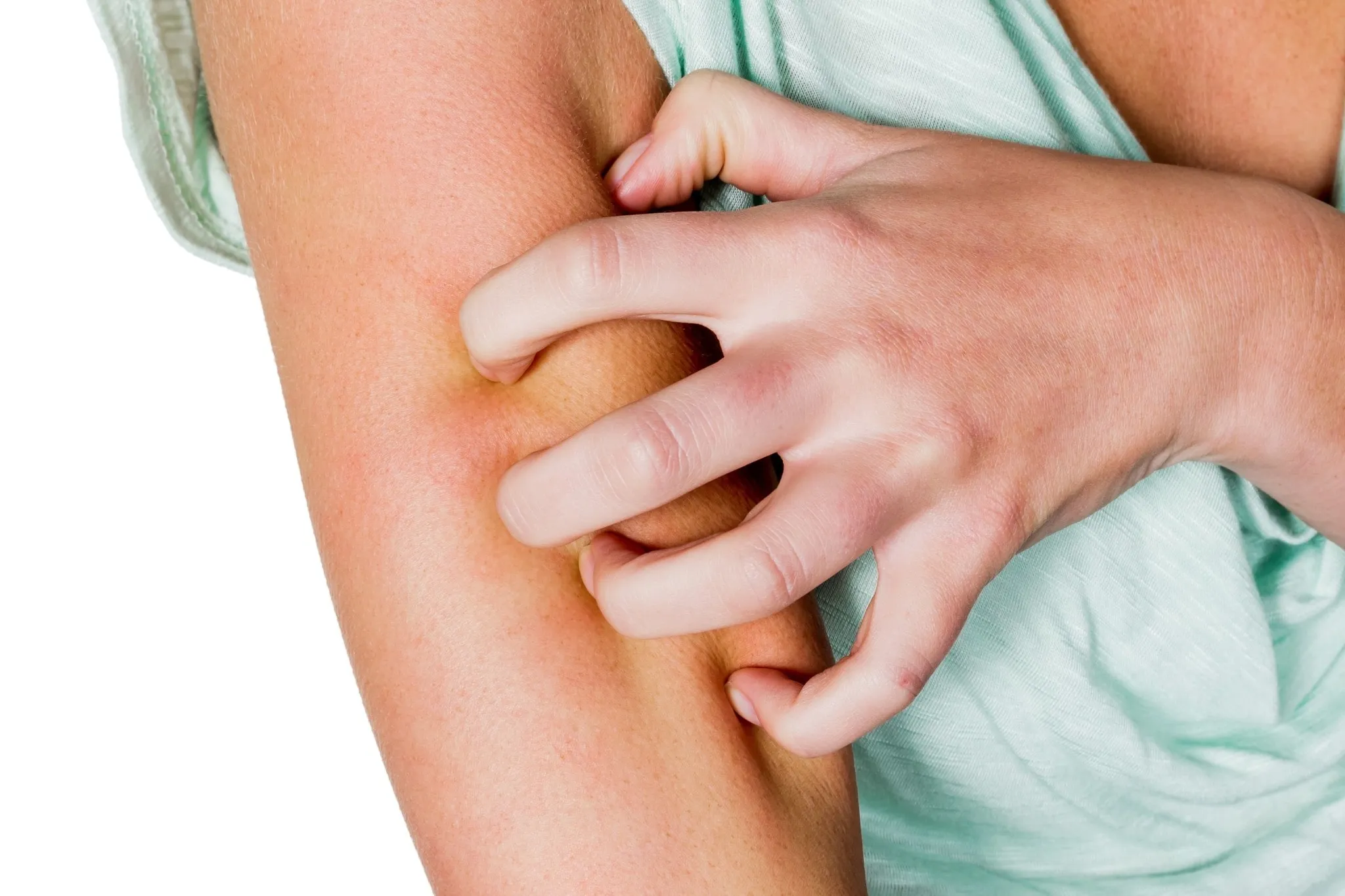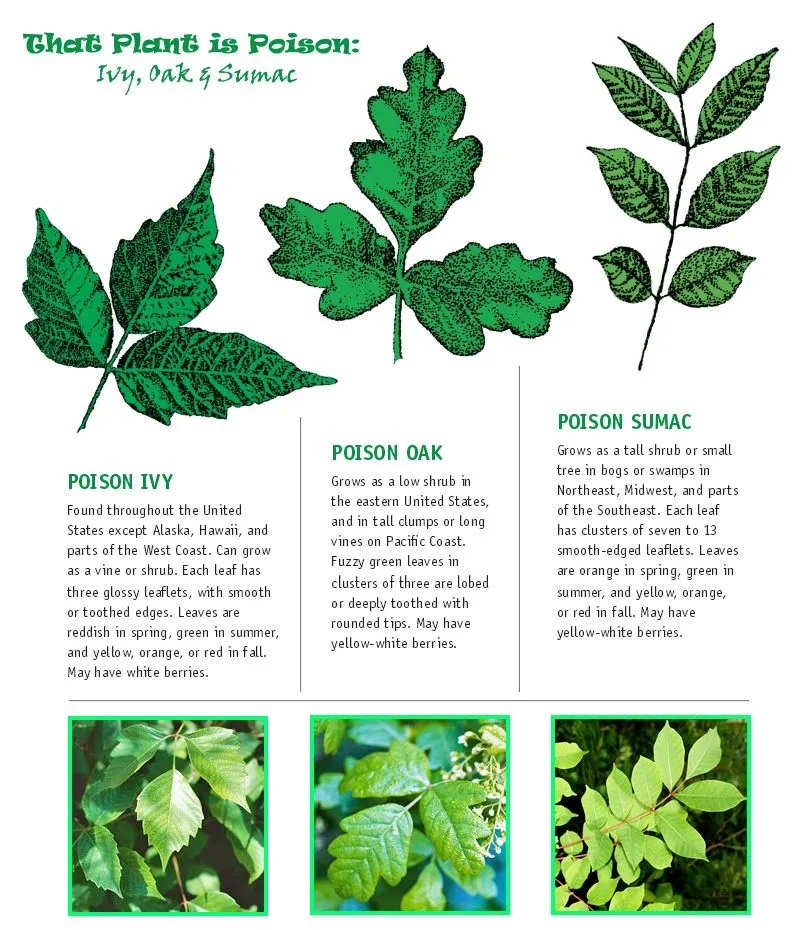Poison Ivy, Poison Oak and Poison Sumac
When you come into contact with poison ivy, poison oak, or poison sumac, your skin develops an itchy rash. The rash is caused by an allergic reaction to the plant oil urushiol. Touching oil-contaminated objects, such as gardening tools, clothing, or a pet's fur, can also cause a rash. You can protect yourself by staying away from the plants.
 Useful Precautions for Poison Ivy, Oak, and Sumac Rash
Useful Precautions for Poison Ivy, Oak, and Sumac Rash
What is poison ivy?
Poison ivy is a common poisonous plant that causes a rash on the skin. Poison oak and poison sumac are two other poisonous plants that cause rashes. These plants produce an oily sap known as urushiol, which causes an irritating, itchy allergic reaction. When you come into contact with a poisonous plant or an object that has come into contact with a plant, you develop an itchy rash. This is an allergic contact dermatitis rash.
How common is a poison ivy rash?
When exposed to poison ivy oil, up to 90% of people develop an itchy rash. You don't need to be exposed to a lot: A reaction can be triggered by 50 micrograms of urushiol, which is less than a grain of salt.
Who might get a poison ivy rash?
Almost everyone who comes into contact with urushiol develops a poison ivy rash. If you have one of the following jobs or hobbies, you are more likely to come into contact with a poisonous plant:
- Hiker or camper.
- Gardener or farmer.
- Landscaper or groundskeeper.
- Worker in the forest.
- Firefighter in the woods.
- Painter for the home.
- Roofer.
What do poisonous plants look like?
Poisonous plants can be found throughout the continental United States. Each type has its own distinct appearance:
- Poison ivy is best known for its poisonous leaves. There are three leaflets on each leaf. "Leaves of three, let them be," as the saying goes. Poison ivy is both a shrub and a vine. In the spring, its summer-green leaves turn reddish, and in the fall, they turn yellow, orange, or red. White berries can be found on a poison ivy shrub.
- Poison oak has three leaflets, similar to poison ivy, but with rounded tips. The undersides of the leaves are fuzzy and lighter in color than the tops. Poison oak is a type of shrub. It is most common in western America. The shrub occasionally bears white or yellow berries.
- Poison sumac is a small tree or shrub with drooping clusters of green berries. (Nonpoisonous sumacs have upright, red berries.) Contact with nonpoisonous sumacs will not result in an allergic reaction.) Each leaf has seven to thirteen smooth leaflets arranged in pairs. Poison sumac grows best in wet, swampy areas.
 Plants and Skin Rashes
Plants and Skin Rashes
What causes a poison ivy rash?
Poison ivy, poison oak, and poison sumac all produce a substance known as urushiol. This oil causes allergies in almost everyone. An allergic reaction occurs when your skin comes into contact with the oil. The resulting itchy rash is a type of allergic contact dermatitis.
What are the symptoms of a poison ivy rash?
No matter which poisonous plant you touch, urushiol oil causes the same allergic reaction — an itchy skin rash. A rash may appear hours or days after initial contact, depending on your skin's sensitivity. Symptoms:
- Blisters are among the symptoms.
- Skin rash that is itchy.
- Swelling and redness
How is a poison ivy rash diagnosed?
Your doctor will examine the rash, assess your symptoms, and ask questions to determine if you have come into contact with a poisonous plant. Aside from poisonous plants, other allergens and irritants can cause contact dermatitis or an itchy rash. Your healthcare provider will want to rule out other skin conditions or causes if you haven't been outside or in contact with plants.
How is a poison ivy rash managed or treated?
Poisonous plant rashes usually go away in a week or two. Meanwhile, the following over-the-counter medications can help relieve the itchy rash:
- Anti-itch creams, including calamine lotion (Caladryl®) and hydrocortisone creams (Cortizone®).
- Antihistamines, such as diphenhydramine (Benadryl®).
- Colloidal oatmeal baths (Aveeno®) and cold compresses to soothe itching.
Your healthcare provider may prescribe an oral steroid, such as prednisone, if the rash becomes more severe or the rash forms on the mucous membranes of the eyes, nose, mouth or genitals.
What are the complications of poison ivy exposure?
If you are exposed to poison ivy, poison oak, or poison sumac, certain situations increase your risk of problems. These elements are as follows:
- Smoke inhalation: When poisonous plants burn, urushiol is released into the air. Inhaling smoke may cause a rash inside your nasal passages, mouth, and throat. The lungs are also affected by oil in the air, which can lead to serious breathing problems.
- Scratching: It's difficult not to scratch this itch. However, if you scratch until your skin bleeds, you risk getting an infection. Bacteria from your fingernails can enter any open wound.
Can a poison ivy rash spread to other parts of the body?
No. Although it appears that a rash is spreading, you are actually developing new rashes on areas of skin that have come into contact with urushiol oil. You may have touched a plant without realizing it in some places, such as if a backpack strap brushed against plants and then touched your bare shoulder. Some rashes develop more slowly than others. The severity of the rash is determined by your skin's sensitivity and the amount of oil you touched.
Is a poison ivy rash contagious?
You cannot get poison ivy from touching someone else's rash. However, if you touch the oil on another person's body or clothing, you may develop a rash. Touching your pet's fur or a contaminated item, such as a gardening tool or camping gear, can also expose you to the oil.
How can I prevent a poison ivy rash?
The best way to avoid developing this itchy rash is to learn how to identify poisonous plants and avoid them.
- Apply isopropyl (rubbing) alcohol to exposed body parts, gardening tools, or other contaminated items to remove the oil if you suspect you've come into contact with a poisonous plant.
- Use a brush to scrub under your fingernails.
- Wash hands that have come into contact with a poisonous plant with dishwashing soap and cool water.
- After being outside, wash your clothes.
- When doing yard work, gardening, farming, or hiking, wear long sleeves, pants, and gloves.
- When bathing pets who have come into contact with poisonous plants, use rubber gloves.
What is the prognosis (outlook) for people with a poison ivy rash?
Most poison plant rashes cause mild (but bothersome) symptoms that resolve within a week or two. A skin rash rarely lasts more than a month. Make an effort not to scratch. Scratching can cause skin breakdown and infection.
When should I call the doctor?
Reach out to your healthcare provider if you have a poison plant rash and you experience:
- Rash covering more than a quarter of your body.
- Rash on the mucous membranes of the eyes, nose, mouth or genitals.
- Red streaks, fever or other signs of infection.
- Signs of anaphylaxis, including breathing difficulties, hives and swelling.
What questions should I ask my doctor?
If you have a poison plant rash, you should consult your doctor.
- Do I need any tests to confirm that the rash is caused by a poisonous plant?
- How can I avoid getting this rash in the future?
- How can I prevent this rash from spreading to my family members?
- What treatments are available to help with itching?
- How long will the rash be present?
- Should I be on the lookout for signs of complications?
A Note from Mediterranean-Beauty One of The Best Spas Columbus OH
It's difficult to resist scratching an itchy poison ivy rash. Fortunately, most rashes clear up within a week with minimal treatment. Consult your doctor for advice on how to get rid of the itch. Remember not to scratch! You may feel better temporarily, but scratching can introduce bacteria into the skin and cause an infection.
Mediterranean-Beauty Spa team is here to offer you advice, resources, and any treatment options you may require (in terms of our profession and natural quality services, because some skin conditions may need clinical experts’ attention).
For FREE consultation and skin analysis system, choosing the best treatment for you and talking about “Useful Precautions for Poison Ivy, Oak, and Sumac Rash – Sensitive an Irritating Skin” Call Us Right Away!
(614) 940-0886